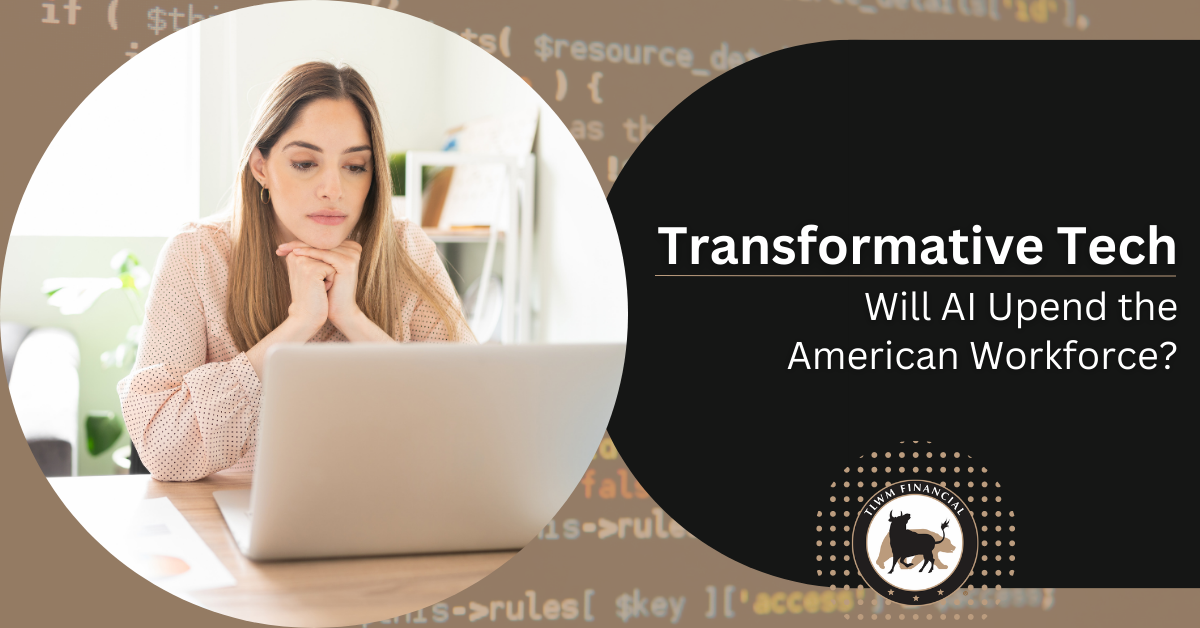Transformative Tech - Will AI Upend the American Workforce?
Submitted by TLWM Financial on July 7th, 2023
A chatbot with uncanny human-like writing abilities has become the poster child for artificial intelligence (AI) since it was released in late 2022, inspiring new levels of attention, excitement, and concern about recent advances in this life-changing technology.
As the race among tech companies to monetize AI picks up speed, it's worth considering how widespread adoption of AI-enabled technologies might affect the economic prospects of workers and businesses.
How AI changes the game
Artificial intelligence uses complex algorithms to sort through data to detect and react to patterns. This allows AI-enabled applications to "learn" from experience. As artificial intelligence has advanced and joined robots, sensors, and other technologies, many tasks have already been automated in ways that were once unimaginable. Smartphone apps map out the fastest routes from place to place and connect drivers-for-hire to people who need a ride. In some cities, driverless cars are being tested on the roads.
Generative AI is powered by large language models, which are deep learning algorithms trained with immense data sets to recognize, summarize, translate, and generate text. These models can create original content in response to questions posed by users, and millions of people are already using them to help write essays, articles, and business communications, code software applications, conduct scientific research, and even craft works of art such as illustrations, graphic designs, and music.1
A known flaw of generative AI systems is that they sometimes "hallucinate," or make up facts, when they can't find enough relevant data to inform a reasonable response. They can also perpetuate the biases of their human developers. But experts say performance can improve as software is "trained" over time.2
Productivity gains and job losses
Advances in technology and automation have been displacing workers for a long time, but the capabilities of generative AI suggest that many more human jobs — including those for skilled professionals — could be eliminated. And the people who still have their jobs will likely be expected to use AI-enabled tools to work faster and more efficiently.
When researchers used AI-powered models to assess the potential effects of generative AI on the workforce, they concluded that 80% of human workers would have at least 10% of their tasks affected, and 19% would have more than half of their tasks affected, which puts them at greater risk of being replaced.3 The long list of occupations that are most exposed to advances in AI includes many types of knowledge workers, such as postsecondary teachers, analysts, lawyers, mathematicians, accountants, human resources specialists, sales representatives, journalists, and other communications professionals.4
By one estimate, generative AI could complement two-thirds of jobs by helping workers complete tasks in less time. Over the next decade, AI adoption could boost labor productivity by about 1.5% per year in the United States (to roughly double the current rate) and 1.4% globally. Productivity, or output per hour of work, is a good indicator of society's prosperity and economic well-being. A surge in productivity of this magnitude would also improve employers' profit margins and raise the world's gross domestic product by 7%, or about $7 trillion.5
However, if large-scale deployment of AI forces too many displaced workers into lower-paying jobs or out of the workforce completely, it could cause a downward spiral of reduced consumer spending that stifles economic growth.
It's also possible that obsolete jobs will be replaced with different types of work, similar to the way agricultural workers shifted into manufacturing and other new industries in the past. If productivity gains bring widespread prosperity, it could raise living standards for society overall. Workers would have more free time and money to spend on leisure pursuits.
Implications for investors
The expected cost savings and higher profit margins to be unlocked by productivity gains is one reason global corporate investment in AI was up from about $80 billion in 2018 to nearly $190 billion in 2022, even before generative AI burst onto the scene in 2023. Large tech companies are investing billions in their quest to integrate AI-enabled features into their existing products (such as social media platforms and search engines). Smaller start-ups are raising money from venture capitalists and working quickly to develop new business models.6
Speedy and successful implementation of AI systems could deliver a competitive advantage, and the prospects of companies that fail to deliver could suffer. Financial markets are likely to reward the winners and punish losers much like they did when other transformative technologies (such as personal computers, the internet, and smartphones) were invented.
Investors have been pouring money into the stocks of companies that they expect to profit from AI, which has helped drive the recent performance surge of large tech stocks.7 But even if the hype around AI turns out to be warranted, investors should keep in mind that new technology ventures tend to be risky. Some AI projects may turn out to be viable and profitable, but many others could fail.
How dangerous could it be?
Some believe the rise of artificial intelligence will make it harder for people to make a living, leading to greater inequality and social unrest. But workforce disruption is not the only threat posed by AI. Another major concern is that bad actors could use deceptive images and video altered by AI (called deepfakes) to cause harm and/or spread misinformation, making it harder for the public to tell the difference between falsehoods and the truth. Even worse is the fear that AI might be used to design deadly weapons that fall into the wrong hands.
Industry leaders have testified before Congress about the potential benefits and dangers of AI, and lawmakers are currently discussing a framework for regulation, including the possibility of a new agency to monitor the industry, set up guardrails, and issue licenses for new AI platforms.8 With AI advancing at a dizzying pace, policymakers may need to act quickly to keep up. And tomorrow's human workers may need to learn new skills more often — and be capable of adapting to change more quickly — than previous generations.
The return and principal value of stocks fluctuate with changes in market conditions. Shares, when sold, may be worth more or less than their original cost.
1. The Wall Street Journal, May 9, 2023
2. Axios, May 22, 2023
3. University of Pennsylvania, March 2023
4. Princeton, University of Pennsylvania, and New York University, March 18, 2023
5. Bloomberg, March 27, 2023
6. Artificial Intelligence Index Report, Stanford University, 2023
7. The Wall Street Journal, May 18, 2023
Content in this material is for general information only and not intended to provide specific advice or recommendations for any individual. All performance referenced is historical and is no guarantee of future results. All indices are unmanaged and may not be invested into directly. The information provided is not intended to be a substitute for specific individualized tax planning or legal advice. We suggest that you consult with a qualified tax or legal professional. LPL Financial Representatives offer access to Trust Services through The Private Trust Company N.A., an affiliate of LPL Financial.
This article was prepared by Broadridge.
LPL Tracking #1-05373204

